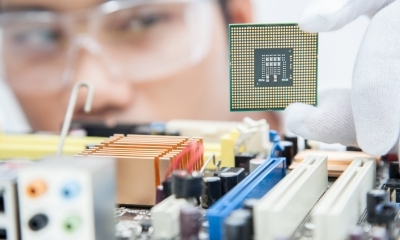10 Breakthrough Technologies of 2014: From Agri Drones to Smart Energy
MIT Technology Review is doubtlessly one of the most credible and prestigious science and technology publications in the world. The information and insights it publishes carry significant weight and reliability. That’s why if you want to know what the most notable new technologies of 2014 are, the list prepared by MIT Technology Review is definitely going to be one of the most credible references to cite.
The following are the 10 new breakthrough technologies of 2014 according to MIT Tech Review.
Relatively Cheap Drones for Agricultural Use
Drones may have been in existence for several years or decades now but their use in the field of agriculture hasn’t been that widespread until they became cheaper. This year, the use of drones in the fields to monitor crops and manage crop pests has increased as drone prices from major companies like PrecisionHawk, Yamaha, and 3D Robotics have dropped to as low as $1,000.
![By Flying Eye (Own work) [CC-BY-SA-3.0 (http://creativecommons.org/licenses/by-sa/3.0)], via Wikimedia Commons](https://techtheday.com/wp-content/uploads/2014/07/Drone-Flying-Eye.jpg)
By Flying Eye (Own work) [CC-BY-SA-3.0 (http://creativecommons.org/licenses/by-sa/3.0)], via Wikimedia Commons
“Ultraprivate” Smartphones
As smartphones and other smart mobile devices became very popular, mobile security and privacy concerns have dramatically increased. Smartphone hacking is said to be on the rise. Due to well-publicized privacy threats posed by government spying and intrusive advertisers, mobile phone companies apparently realized that phone users would want enhanced protection. So devices such as the Blackphone and CryptoPhone came to being.
Brain Mapping
Neuroscientists Katrin Amunts of Julich Research Center, Alan Evans of the Montreal Neurological Institute, and Karl Deisseroth of Stanford University are three of the most notable figures in recent attempts at brain mapping. They have contributed to the creation of a new brain map that shows significantly greater details, serving as a more reliable guide to understanding the human brain’s overwhelming complexity.
Neuromorphic Chips
Qualcomm, IBM, HRL Laboratories, and the Human Brain Project are at the forefront of the development of the computer chips of the future. The computers of the future are bound to become more astute and be able to sport far more advanced artificial intelligence thanks to the development of computer chips that are employing an alternative design and configuration comparable to the way the brain works. As traditional chips are reaching their inevitable performance limits, a new design or configuration based on the brain’s neuromorphic structure is expected to be the solution.
Genome Editing
Genetic engineering is a quite common phrase so not many will likely be surprised with a breakthrough in this field. However, it’s worth reporting that two monkeys were artificially conceived and successfully given genetic mutations with the use of a genome-tool at the research campus of Kunming Biomedical International and its affiliated Yunnan Key Laboratory of Primate Biomedical Research. This is an important breakthrough in the field of genomics as it can help improve the study of human diseases. The ability to change targeted genes in primates can greatly facilitate the study of human health conditions.
3D Printing at the Microscale
3D printing is likewise not a new technology but its advancement has led to breakthrough this year. Further developments in 3D printing technology have led to the ability to make use of a wide variety of materials (for the “ink” in particular) that can be used in precise amounts and manipulation or application at the microscopic scale. Microscale 3D printing is expected to provide considerable benefits in the production of biological materials such as artificial organs and cyborg parts.
![By Slowking4 (Own work) [CC-BY-SA-3.0 (http://creativecommons.org/licenses/by-sa/3.0)], via Wikimedia Commons](https://techtheday.com/wp-content/uploads/2014/02/3d-printer.jpg)
By Slowking4 (Own work) [CC-BY-SA-3.0 (http://creativecommons.org/licenses/by-sa/3.0)], via Wikimedia Commons
Mobile Collaboration and Mobile Office Applications
Desktop and laptop computer sales have greatly declined over the years as mobile devices gained sweeping popularity. Naturally, as more people prefer to spend more time with their mobile devices, it has become inevitable to port the many useful and convenient functions that can be possibly ported from desktop computers to smartphones, tablets, and other mobile devices. Mobile collaboration tools and office applications are some of the most important desktop/laptop tools that have been made available (in stable and reliable forms) to mobile devices this year—and their popularity and stability is now being considered as one of the breakthrough technologies of 2014.
VR Headgear
It all started with Oculus Rift and now, a number of companies have produced their own versions of a virtual reality headgear that can be used for a number of purposes (not just for gaming). Of course, the idea of VR headgear is nothing new. What makes it a breakthrough this year is the introduction of more advanced technologies such as higher quality thin and light displays and additional sensors that create more immersive experiences. Also, the lower prices figure in.
![By Tmfroehlich (Own work) [CC-BY-SA-3.0 (http://creativecommons.org/licenses/by-sa/3.0)], via Wikimedia Commons](https://techtheday.com/wp-content/uploads/2014/04/Oculus-Rift-Dev-Kit.jpg)
By Tmfroehlich (Own work) [CC-BY-SA-3.0 (http://creativecommons.org/licenses/by-sa/3.0)], via Wikimedia Commons
Agile, Balancing, and Fluid-Moving Robots
Robots have been stereotyped as slow and “mechanical” moving. Their movements are perceived to lack fluidity and speed, often associated with movements that noticeably follow specific and repeated patterns. This year, robots with walking legs from Boston Dynamics, Schaft, and Honda have been shown to be capable of striding over uneven and unsteady surfaces in a manner comparable to animal or human movement.
Smart Wind and Solar Power
As Big Data and more advanced artificial intelligence make their way to peoples’ everyday lives, they also provide the benefit of facilitating the generation of more accurate forecasts that make it viable to integrate more renewable energy into the power supply of many cities. Big Data and AI are being used to address the intermittency of renewable energy as demonstrated by Xcel Energy, GE Power, and the National Center for Atmospheric Research.


![By WiNG (Own work) [CC-BY-SA-3.0 (http://creativecommons.org/licenses/by-sa/3.0)], via Wikimedia Commons](https://techtheday.com/wp-content/uploads/2014/09/solar-power.jpg)